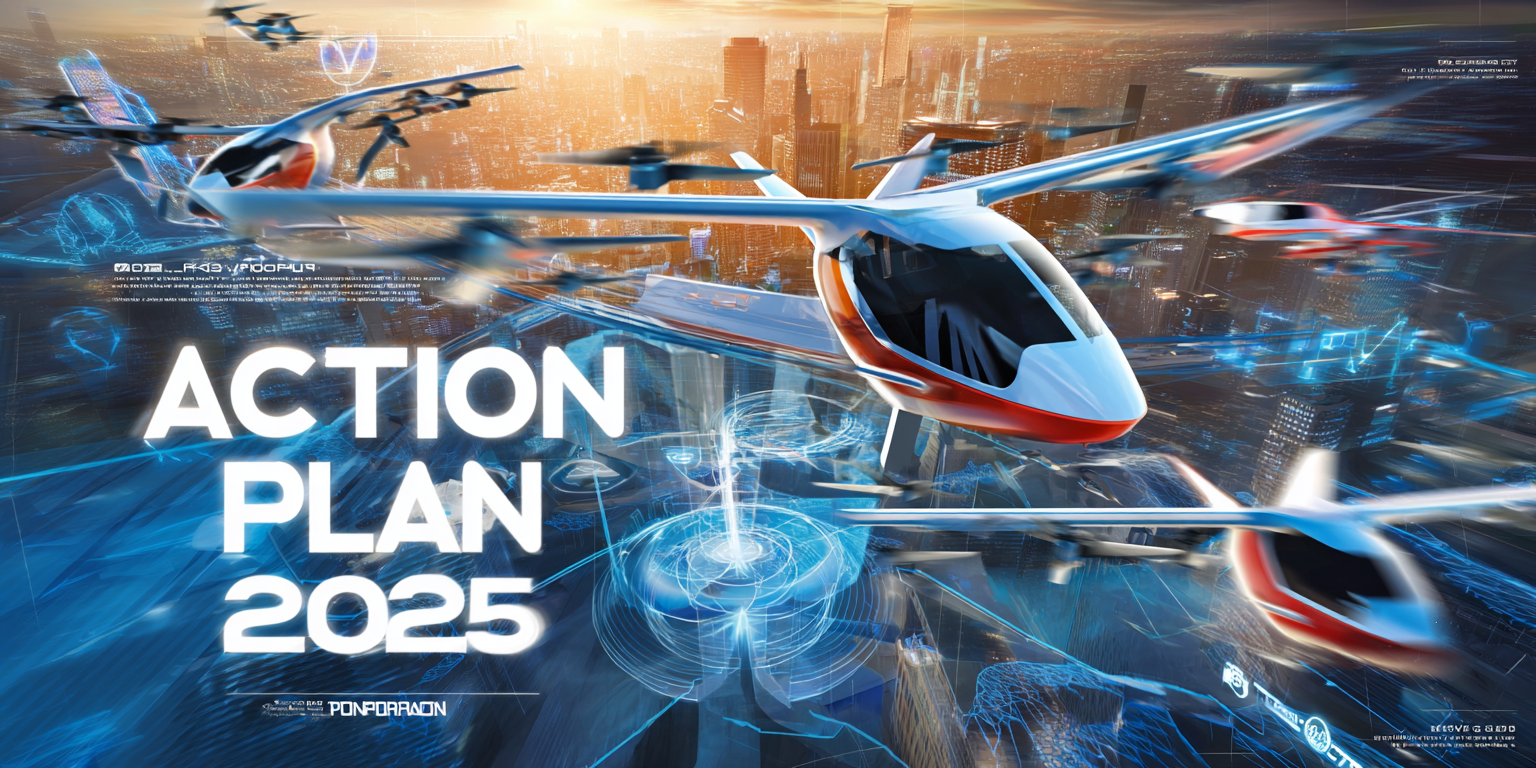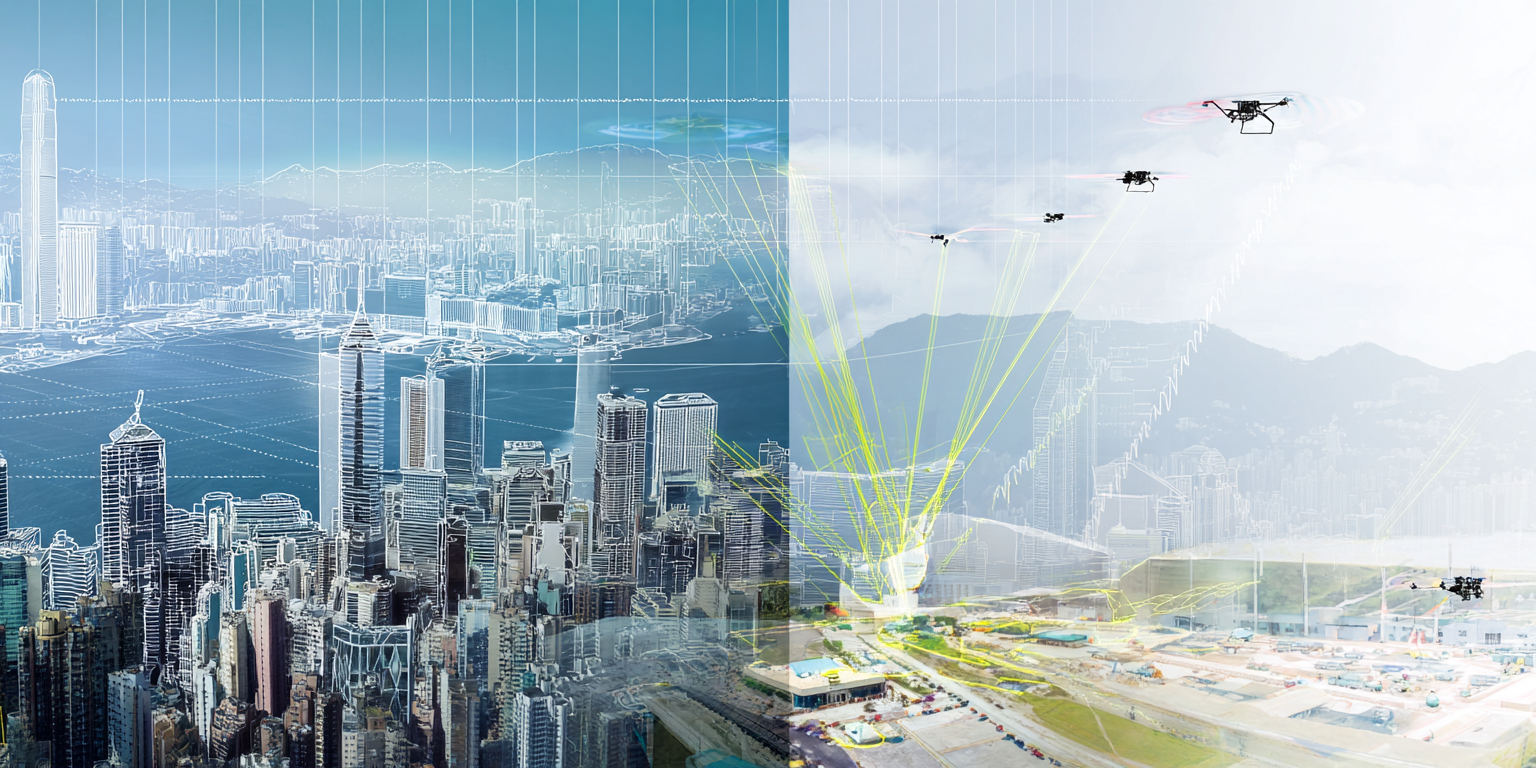Beneath the surface of every successful urban air mobility operation lies an invisible digital brain. This brain processes thousands of calculations each second, determining whether three-dimensional city transportation succeeds or dissolves into aerial gridlock.
The future of low-altitude aviation depends entirely on virtual modeling platforms that most passengers will never see. These systems create sophisticated digital replicas that orchestrate every landing, departure, and charging cycle before they materialize in physical reality. Without this technology, mapping every operational parameter, eVTOL aircraft would face the same congestion problems that plague today’s ground transportation, just moved 500 feet higher into the urban canopy.
Aerial Precision for Low Altitude Operations
Modern vertiport facilities demand operational precision that far exceeds human analytical capabilities. These installations coordinate aircraft movements, passenger flows, energy distribution, and maintenance activities. They simultaneously account for weather patterns, air traffic constraints, and emergency protocols. Virtual modeling platforms address this complexity by continuously updating replicas from sensor data. These systems measure everything from wind velocity and battery temperatures to passenger queue lengths and charging station availability.
The global digital twin market reached $19.80 billion in 2024. Projections indicate explosive growth to $471.11 billion by 2034, representing a compound annual growth rate of 37.29%. This dramatic expansion reflects the technology’s transition from experimental to operational across multiple industries. Aviation leads implementation sophistication.
These platforms operate across hierarchical levels, from microscopic component monitoring to comprehensive facility management. Component twins track battery chemistry and thermal characteristics. Asset twins illustrate how multiple components combine to form functional systems. System twins reveal how assets merge into operational aircraft. Process twins capture complete vertiport operations from arrival through departure. This layered approach enables operators to understand facilities from the molecular behavior of individual components to the comprehensive operational landscape.
The technology extends far beyond simple computer modeling. Modern aviation virtual platforms process between 4,800 and 6,200 data points per second from advanced sensor networks. Monitoring happens with an average latency of just 12 milliseconds. These systems achieve 97.3% accuracy in simulating potential failure scenarios. Maintenance teams can develop intervention strategies before physical issues arise. Predictive maintenance algorithms demonstrate an average accuracy of 92.5% in identifying component failures. They typically spot problems 18.7 days before they would occur under traditional maintenance approaches.
CycloTech’s summer 2025 flight test campaign provides concrete validation of these capabilities in aviation applications. The company achieved precise simulation-to-flight correlation. Virtual modeling systems accurately predict the behavior of real-world aircraft. This accomplishment validates the technology’s readiness for commercial eVTOL operations.
Federal Requirements and Standards Take Shape
The Federal Aviation Administration’s Engineering Brief 105A, published December 27, 2024, establishes critical technical standards that virtual modeling platforms must incorporate for regulatory compliance and operational safety. This updated guidance introduces fundamental changes in vertiport design philosophy. The FAA shifts from prescriptive requirements to performance-based standards while maintaining rigorous safety protocols.
Engineering Brief 105A officially classifies vertiports as specialized heliports with distinct requirements for aircraft featuring three or more propulsive units. Traditional helicopter markings have been replaced with “VTL” designations on touchdown and liftoff areas. The geometry defines RD (Rotor Diameter) as the smallest circle that encloses the propulsion units. This represents a subset of the controlling dimension D that excludes the full aircraft envelope.
Virtual modeling platforms must distinguish between facility types based on definitions established in ASTM International Standard F3423. Full-service vertiports offer comprehensive capabilities, including maintenance, charging, and storage operations. Vertistops provide simplified facilities limited to passenger and cargo operations. This distinction affects how these systems allocate resources, schedule operations, and predict capacity constraints throughout operational cycles.
The Downwash/Outwash Caution Area requirements present unique modeling challenges for virtual systems. Simulation platforms must model air movement velocities exceeding 34.5 mph to ensure accurate safety modeling and operational planning capabilities. This requirement enables the prediction of how weather conditions and aircraft operations interact with each other. These interactions create potential safety hazards that require real-time mitigation strategies.
The FAA held an EB 105A Vertiports Industry Day on January 14, 2025, to provide an overview of the final EB update. The agency discussed critical changes made to the document and answered audience questions. The FAA’s next effort involves incorporating this information into the next revision of Heliport Design Advisory Circular AC 150/5390-2D. According to the U.S. Congressional mandate, the agency must accomplish this by the end of 2025.
International Standards Align
International regulatory development adds complexity to requirements for virtual modeling platforms. The UK Civil Aviation Authority’s eVTOL Delivery Model, published September 2025, establishes clear pathways for commercial eVTOL operations by the end of 2028. This framework emphasizes collaboration among industry, government, and other relevant stakeholders. Authorities build on existing aviation rules while prioritizing safety and enabling industry growth.
The CAA’s three-phase approach includes “Flying Now,” “Flying Tomorrow,” and post-2030 developments. This structured timeline provides developers with specific milestones for capability development and verification of regulatory compliance. International regulatory alignment becomes crucial as operators plan multi-jurisdictional services. These operations require consistent operational standards and digital integration capabilities across borders.
Pioneer Projects Define Operational Standards
The acceleration from prototype testing to commercial operations has driven adoption of virtual modeling platforms across the low-altitude economy. Skyports Infrastructure, partnering with Cranfield University, developed the world’s first vertiport Fast-Time Simulation using CAST by ARC software. This breakthrough illustrates how simulation technology transitions from theory to practical application.
This comprehensive approach creates, according to Skyports, “a simplified version of the real world in a virtual world.” The Skyports platform encompasses all critical vertiport infrastructure components. These include final approach and takeoff areas, stands, taxiways, and passenger terminals. The system simulates entire operational days with aircraft arrival and departure schedules determining activity flow patterns.
Each passenger makes autonomous decisions based on predefined rules, such as choosing shorter check-in queues. The simulation captures the complex interactions that characterize real-world operations. This behavioral modeling enables identification of bottlenecks, optimization opportunities, and emergency response procedures before physical facility construction begins.
Industry Partnerships Accelerate Development
The partnership between ANRA Technologies and Future Flight Global represents forward-looking approaches to the development of virtual modeling for eVTOL operations. Over a 12 to 24-month timeline beginning January 2025, ANRA assists Future Flight Global in creating virtual replicas of planned operations. These platforms simulate eVTOL flights and model aircraft integration with airspace and ground infrastructure. This collaboration addresses scaling challenges through various operational scenarios and logistical considerations that traditional aviation planning approaches often overlook.
Vancouver International Airport continues to advance its virtual modeling platform, initially launched in March 2022 following a $4 million investment. The airport utilizes Unity’s real-time 3D platform. This creates virtual, interactive representations of terminal, airfield, and Sea Island infrastructure. The platform now serves 200 airport operations staff through runtime applications while providing operational situational awareness to over 600 staff members.
The system integrates sensors, historical records, and real-time operational data to provide a comprehensive view of the system’s performance. Operators can utilize 2D and 3D visualizations to inform data-driven decision-making processes. This implementation demonstrates how virtual modeling platforms transform complex operational environments into manageable, optimized systems. Safety and efficiency improve simultaneously.
Major Hub Implementations
Dallas/Fort Worth International Airport pioneered virtual modeling projects for maintenance and operations management. The DFW platform represents what sources describe as “the first digital twin of an active runway in the industry.” The system incorporates 3D models from recent expansions and physical scans of over 17,000 acres of airport assets. DFW utilizes 40 years of operational data to create comprehensive virtual replicas supporting predictive maintenance and operational optimization.
NATS Services’ Project AMEC demonstrates practical integration of simulation technology with Advanced Air Mobility operations. Using sophisticated simulations, NATS Services validated operational concepts for eVTOLs and drones in controlled and uncontrolled environments. Testing included operations within London’s congested airspace. The project’s findings directly informed the development of Concepts of Operations and digital solutions designed to support future Advanced Air Mobility and integrated traffic management.
Key innovations from Project AMEC include the Master Control Room interface, Airspace Manager, and vertiport assessment tools. These serve as critical enablers for the safe and scalable integration of crewed and uncrewed aircraft into shared airspace. The Airspace Manager role provides required support to Advanced Air Mobility operators. Flight plans receive approval or amendment within minutes. The system leverages sophisticated digital monitoring and pre-flight deconfliction capabilities. Operators ensure safe and seamless operations without adding to air traffic controller workload demands.
Rapid Financial Returns Drive Adoption
Airlines that implement virtual modeling technology achieve an average return on investment within 16.4 months. The total five-year financial benefits average 4.7 times the implementation cost. These returns stem from multiple sources. Maintenance optimization, operational efficiency improvements, and enhanced capacity utilization all contribute to positive financial outcomes.
Adoption of these platforms enables a 42.7% reduction in unscheduled maintenance events. Component lifecycles extend by an average of 26.3% across multiple aircraft types. For European carriers, this translates to approximately €3.2 million in annual savings per wide-body aircraft in maintenance costs alone. Additional operational savings from reduced delays and cancellations reach an estimated €1.8 million per aircraft annually.
Vertiport-Specific Benefits
For vertiport operations, predictive capabilities translate to an 84.6% reduction in Aircraft on Ground incidents. Maintenance-related delays decrease by 76.3%. These improvements directly impact operational capacity and the potential for revenue generation. Virtual modeling investment becomes economically attractive for vertiport operators planning high-frequency operations.
McKinsey research indicates that deployments show return on investment within six to 12 months, primarily in operations optimization applications. Government infrastructure investments utilizing this technology demonstrate potential efficiency improvements of 20% to 30%. This suggests substantial benefits for the public sector upon implementation.
Research shows that 92% of companies tracking ROI see returns above 10%. Half of the companies reported returns above 20%. Beyond immediate ROI, 74% of surveyed executives expect to increase their spending on these platforms next year. This indicates sustained confidence in the technology’s value proposition.
Global Infrastructure Surge
Global vertiport infrastructure planning reached 1,504 facilities worldwide as of February 2025. This represents $1.55 billion in investment commitments. However, industry analysis suggests only 980 vertiports will actually be constructed between 2025 and 2029 due to program failures and regulatory delays. This execution gap highlights the critical need for virtual modeling systems that validate operational concepts before commencing expensive construction projects.
China dominates with over 750 planned vertiports, representing more than 50% of the global total. Shenzhen plans to have over 1,200 takeoff and landing platforms by 2026. This requires simulation platforms capable of modeling operational density that significantly challenges traditional air traffic management approaches.
United States Accelerates Development
The United States has assembled an impressive vertiport development pipeline with 92 cities and airports drafting Advanced Air Mobility plans. This acceleration followed the “Unleashing American Drone Dominance” executive order in June 2025. Major urban hubs, including New York City, Los Angeles, Miami, Dallas, Chicago, and San Francisco, have active plans for eVTOL operations. Virtual modeling platforms must simulate these complex urban integration challenges to ensure the successful deployment and implementation of these solutions.
Strategic co-location approaches address integration challenges by sharing infrastructure costs among complementary high-demand users. Dallas’s Vertisite initiative demonstrates this approach. The project co-locates a vertiport with an Amazon Web Services data center and public electric vehicle charging hub. The facility allocates $8.3 million in substation upgrade costs among three parties.
Energy grid Infrastructure Challenges
Fast recharging operations require a substantial amount of available energy. Integration typically requires legacy grid infrastructure that may lack sufficient capacity. A single vertiport supporting 100 eVTOLs requires 40 to 60 MWh of energy daily. This equals the power needed for approximately 30,000 homes in the United States. Peak demand reaches 1.5 to 2 MW during high-frequency operations.
NREL research for the FAA indicates that potential eVTOL charging demand could significantly impact grid infrastructure and operating parameters. An average vertiport requires a charging capacity of 1 megawatt or greater for consistent operations—that amount of electricity powers around 800 homes. Most sites would need to update their local electric infrastructure. Utilities need to be involved early in planning because vertiports represent an unusual load profile. They would increase site demand by six to seven times in most cases.
Environmental Management and Sustainability
Virtual modeling technology delivers measurable environmental benefits for vertiport operations through sophisticated optimization capabilities. Research indicates that integrating these platforms into environmental management results in a 30% reduction in resource usage. Companies achieve substantial energy efficiency improvements through real-time monitoring and predictive optimization.
These virtual systems enable continuous monitoring of key environmental performance indicators. Operators receive real-time dashboards of emissions, water usage, and energy consumption patterns. For vertiport operations, simulation platforms predict environmental consequences of operational decisions. These include optimizing charging schedules, altering flight patterns, or implementing renewable energy integration strategies.
Virtual modeling enables comprehensive tracking of Scope 1, 2, and 3 emissions across vertiport operations. From on-site energy consumption to supply chain impacts, these systems enable holistic management of carbon footprints throughout operational lifecycles. The technology supports sustainable building performance optimization through sophisticated simulation of heating, ventilation, and air conditioning usage, lighting management, and occupancy modeling. All aim at minimizing energy consumption while maintaining operational efficiency.
These platforms enable predictive energy management that considers battery chemistry, charging curves, and smart grid integration. This prevents inefficient energy usage patterns characteristic of less sophisticated systems. Advanced implementations incorporate real-time Life Cycle Assessment capabilities. Systems continuously update environmental footprints throughout vertiport development and operations. This approach reduces manual data collection requirements while improving precision in environmental impact measurements.
Research demonstrates that this technology enables “smarter, greener designs that meet sustainability goals while improving efficiency and resilience in construction projects” when combined with lean construction processes and sustainable supply chain management. For vertiport infrastructure, this translates to optimized material usage, reduced construction waste, and enhanced operational efficiency.
Layered Defense Strategies Security Architecture and Threat Mitigation
Current cybersecurity approaches for vertiports adapt existing aviation and critical infrastructure security protocols through layered defense strategies. These include physical security measures to restrict unauthorized access, cybersecurity protocols for vertiport systems, and operational security to manage passenger and vehicle flows safely.
Critical security categories include operational disruption through system outages and flight cancellations. Safety compromise through malicious manipulation of flight paths or emergency protocols poses severe risks. Data exfiltration of sensitive passenger information poses a threat to privacy. Reputational damage affects public trust in Advanced Air Mobility operations.
Interconnected Vulnerability Landscapes
The interconnectedness of vertiport systems with broader urban networks creates complex vulnerability landscapes. Compromises in one area can trigger cascading failures in other areas. Vertiports rely on seamless integration with air traffic management, energy grids, and city platforms. These interdependencies mean attacks on city electrical grids could directly incapacitate vertiport charging infrastructure. This renders eVTOL fleets inoperable.
Advanced security architectures require autonomous threat detection and response systems. These implement artificial intelligence-driven capabilities to identify and neutralize cyber threats in real-time. Decentralized security architectures distribute controls across virtual networks to prevent single points of failure. This makes compromising entire systems more difficult for attackers.
Expanding Attack Surfaces
The rapid pace of technological innovation within the Advanced Air Mobility industry presents significant challenges. As eVTOL aircraft and vertiport systems become more sophisticated, integrating distributed propulsion, 5G communication, and autonomous flight systems, the attack surface expands substantially. Legacy systems found in existing infrastructure that Vertiports integrate with present additional vulnerabilities.
Cyber-physical fusion centers represent emerging solutions. These establish integrated operational centers that monitor both cyber and physical security domains. This unified approach enables rapid response to complex, multi-domain incidents. Such incidents characterize modern threat environments targeting critical infrastructure systems.
Technical Architecture and Integration
Core Computing Infrastructure
Modern implementations require cloud-based computing architectures providing substantial processing power. Edge computing handles time-critical operations locally. Machine learning algorithms process information to identify patterns, predict future conditions, and continuously optimize operations. Systems improve with every flight, passenger interaction, and weather change.
Advanced simulation capabilities include discrete event simulation engines, agent-based modeling, physics-based modeling, and Monte Carlo simulation methods. These systems run thousands of “what if” scenarios simultaneously. Operators determine optimal responses to changing conditions across multiple operational parameters.
External System Integration
Integration with external systems connects vertiport platforms to air traffic management, weather services, emergency services, and ground transportation networks. In urban environments, operational independence becomes impossible. Problems anywhere can cascade throughout transportation systems. This requires coordinated response capabilities.
Aircraft tracking systems combine radar, ADS-B, and visual tracking to follow every eVTOL movement throughout operational airspace. Environmental monitoring captures data on wind speed, temperature, humidity, precipitation, and visibility affecting flight operations. Passenger flow monitoring utilizes computer vision, radio-frequency identification tracking, and mobile device analytics. These systems analyze patterns of facility navigation.
Energy Management Complexity
Energy management systems track electrical consumption, charging station usage, and battery status for every aircraft. Unlike traditional aviation, which treats fuel as a commodity pumped quickly into aircraft, electric aircraft operations require sophisticated energy management. Operators consider factors such as battery chemistry, charging curves, thermal management, and smart grid integration.
The industry moves toward standardization. The Combined Charging System (CCS) emerges as the preferred universal fast-charging standard for eVTOLs. Standardizing charging infrastructure represents a crucial step in making electric aviation commercially viable. Adopting CCS ensures interoperability across different eVTOL models and vertiport networks.
Future Trajectories and Strategic Implications
Government Recognition and Support
The convergence of aviation innovation, artificial intelligence, and urban planning through virtual modeling platforms provides the technological foundation necessary to realize the full potential of three-dimensional urban mobility. The White House eVTOL Integration Pilot Program and updated FAA guidance demonstrate government recognition of virtual modeling’s essential role. Scaling urban air mobility operations safely and efficiently depends on these systems.
Foremost aerospace leaders recognize the critical importance of this technology in their operations. According to recent industry surveys, the majority of aerospace leaders look to AI and virtual modeling platforms as key enablers for their future operations. This technology provides the precision and safety margins required for the next generation of aviation systems, including eVTOL aircraft.
Operational Optimization and Autonomy
The integration of advanced simulation capabilities with real-world operations enables unprecedented operational optimization. These platforms allow operators to test scenarios, predict maintenance needs, and optimize flight paths before implementing changes in physical systems. This capability becomes particularly valuable as urban airspace becomes increasingly congested with both manned and unmanned aircraft.
Virtual modeling technology also enables the development of autonomous flight capabilities by providing comprehensive virtual environments for testing and validation. Machine learning algorithms trained on simulation data can make real-time decisions about flight paths, energy management, and emergency responses. Accuracy levels approach or exceed human capabilities in many scenarios.
Systemic Transportation Transformation
The economic implications extend beyond individual operators to entire urban transportation systems. Cities implementing comprehensive virtual modeling platforms for their transportation infrastructure can optimize traffic flow across multiple modes of transportation. This reduces congestion and improves air quality while enabling new forms of mobility that were previously impractical.
As the urban air mobility industry evolves from prototype demonstrations to commercial operations, the virtual foundations established today will support aerial transportation networks of tomorrow. These systems will enable futures where the sky becomes an integral part of the daily transportation experience. The invisible intelligence systems operating behind every successful flight will determine whether urban air mobility fulfills its promise of faster, cleaner, and more efficient transportation for millions of city dwellers worldwide.
The success of this ambitious vision rests entirely on the sophistication and reliability of virtual modeling platforms that orchestrate every aspect of three-dimensional urban transportation. Without these systems processing thousands of variables each second, the promise of aerial mobility would remain grounded in concept rather than soaring through implementation.




